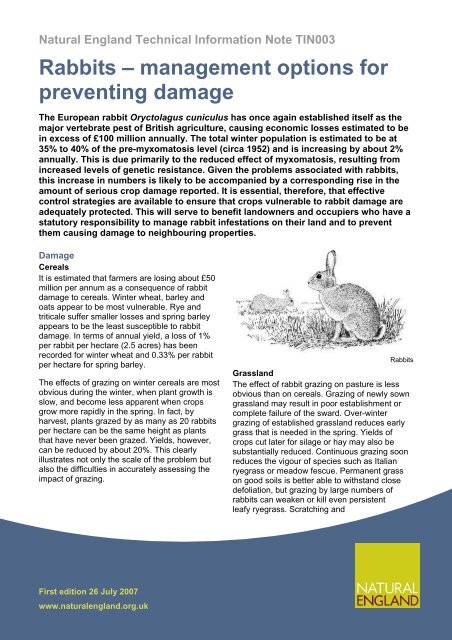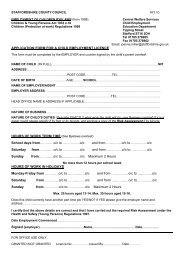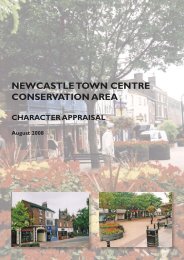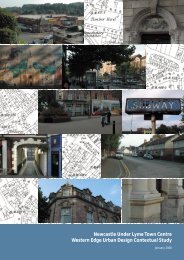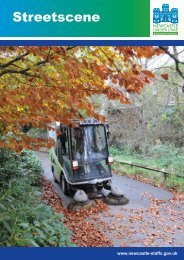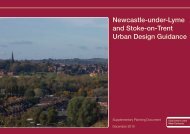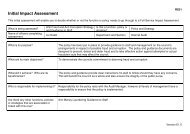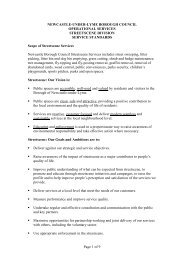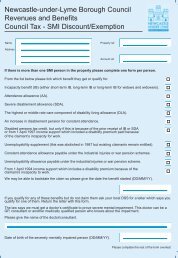Natural England Technical Information Note TIN003 - Rabbits ...
Natural England Technical Information Note TIN003 - Rabbits ...
Natural England Technical Information Note TIN003 - Rabbits ...
Create successful ePaper yourself
Turn your PDF publications into a flip-book with our unique Google optimized e-Paper software.
<strong>Natural</strong> <strong>England</strong> <strong>Technical</strong> <strong>Information</strong> <strong>Note</strong> <strong>TIN003</strong><strong>Rabbits</strong> – management options forpreventing damageThe European rabbit Oryctolagus cuniculus has once again established itself as themajor vertebrate pest of British agriculture, causing economic losses estimated to bein excess of £100 million annually. The total winter population is estimated to be at35% to 40% of the pre-myxomatosis level (circa 1952) and is increasing by about 2%annually. This is due primarily to the reduced effect of myxomatosis, resulting fromincreased levels of genetic resistance. Given the problems associated with rabbits,this increase in numbers is likely to be accompanied by a corresponding rise in theamount of serious crop damage reported. It is essential, therefore, that effectivecontrol strategies are available to ensure that crops vulnerable to rabbit damage areadequately protected. This will serve to benefit landowners and occupiers who have astatutory responsibility to manage rabbit infestations on their land and to preventthem causing damage to neighbouring properties.DamageCerealsIt is estimated that farmers are losing about £50million per annum as a consequence of rabbitdamage to cereals. Winter wheat, barley andoats appear to be most vulnerable. Rye andtriticale suffer smaller losses and spring barleyappears to be the least susceptible to rabbitdamage. In terms of annual yield, a loss of 1%per rabbit per hectare (2.5 acres) has beenrecorded for winter wheat and 0.33% per rabbitper hectare for spring barley.The effects of grazing on winter cereals are mostobvious during the winter, when plant growth isslow, and become less apparent when cropsgrow more rapidly in the spring. In fact, byharvest, plants grazed by as many as 20 rabbitsper hectare can be the same height as plantsthat have never been grazed. Yields, however,can be reduced by about 20%. This clearlyillustrates not only the scale of the problem butalso the difficulties in accurately assessing theimpact of grazing.<strong>Rabbits</strong>GrasslandThe effect of rabbit grazing on pasture is lessobvious than on cereals. Grazing of newly sowngrassland may result in poor establishment orcomplete failure of the sward. Over-wintergrazing of established grassland reduces earlygrass that is needed in the spring. Yields ofcrops cut later for silage or hay may also besubstantially reduced. Continuous grazing soonreduces the vigour of species such as Italianryegrass or meadow fescue. Permanent grasson good soils is better able to withstand closedefoliation, but grazing by large numbers ofrabbits can weaken or kill even persistentleafy ryegrass. Scratching andFirst edition 26 July 2007www.naturalengland.org.uk
<strong>Natural</strong> <strong>England</strong> <strong>Technical</strong> <strong>Information</strong> <strong>Note</strong> <strong>TIN003</strong><strong>Rabbits</strong> – management options for preventing damageburrowing can degrade pasture still further byencouraging the establishment of weeds such asnettles, thistles and ragwort. In terms of annualyield, recent studies have indicated the loss tobe almost 1% per rabbit per hectare.Other cropsRabbit damage has been recorded to a widerange of crops in Britain. Besides cereals andgrassland, some of the most important includeroots, brassicas and market garden crops, whichcan all suffer severe damage, both to thegrowing plants and the marketable end product.Trees<strong>Rabbits</strong> can damage or kill planted nursery stockand young trees of many species. Damage tothe bark of large trees can also be serious andsemi-mature hedgerows may also be vulnerable.In extreme circumstances, rabbits may preventnatural regeneration in woodlands. Damageranges from the eating of young seedlings to thedestruction of leading shoots, the browsing ofbranches and removal of bark. The burrowingactivities of rabbits can also undermine rootsystems.Damage to archaeological sites, monumentsand landscapesAnimal burrowing on archaeological sites resultsin the disturbance and sometimes destruction ofartefacts, ecofacts and buried land surfaces. Italso leads to the destabilisation of monuments,which in turn can lead to an altering of amonuments profile. Damage by burrowingshould be prevented or avoided because ourarchaeological resource is finite and containsirreplaceable information that is important to thestudy of the human past.ManagementRabbit populations can withstand high mortalityfrom natural causes, therefore control effortsmust add to, and not merely replace, thesecauses if direct control is to be effective.Because of the size of the effort required, andthe rabbit's inherent capacity for populationincrease, complete eradication is impractical.Instead, the aim should be to reduce rabbitnumbers to levels at which the damage theycause is economically acceptable. Whereaccess can be gained to burrows, gassing -accompanied by careful habitat management toreduce rabbit harbourage, if necessary - is themost effective method of control. In somesituations, other techniques may be appropriate.The most effective time for control is fromNovember to March, although earlier action maybe needed on autumn cereals showing signs ofheavy grazing. There are four main reasons forthis recommendation:• Mortality from natural causes will have reducedrabbit numbers to their lowest level by thewinter. Up to 90% of young rabbits born duringthe summer will have died by this time withouthuman intervention.• Action at this time will reduce the adultbreeding population before the next breedingseason begins. Each doe killed during thisperiod can mean at least 20 fewer youngrabbits born next summer.• Reduction of numbers during this period willreduce damage to vulnerable autumn sowncrops.• Vegetation is dying back, making access toburrows easier.More effective results will be achieved ifadjoining land is treated at the same time in aco-operative exercise. <strong>Rabbits</strong> do not respectboundaries, and joint action will remove animalsthat use burrows on one holding and feed onanother. Control over a substantial block of landwill also reduce the rate of re-infestation.The quality and amount of harbourage are majorfactors that can determine the number of rabbitsin a particular area. Habitat management shouldtherefore play an integral part of any successfulrabbit control programme. Scrub and groundcover may need to be thinned sufficiently to giveaccess to all burrows; this is essential wheregassing is planned. Also, where practicable,burrow systems should be destroyed followingcontrol operations. Appropriate measures shouldbe taken to minimise damage to other wildlifeand habitats. For example, scrub clearanceshould be avoided during the bird-nestingseason.Page 2
<strong>Natural</strong> <strong>England</strong> <strong>Technical</strong> <strong>Information</strong> <strong>Note</strong> <strong>TIN003</strong><strong>Rabbits</strong> – management options for preventing damageLegal considerationsUnder the Wild Mammals (Protection) Act 1996,it is an offence to intentionally inflict unnecessarysuffering, as specified by the Act, on any wildmammal. This legislation may need to beconsidered where the destruction of occupiedwarrens and burrow systems is beingcontemplated.Under Section 12 of the Pests Act 1954, it is anoffence to knowingly spread myxomatosis touninfected rabbits. The Specified AnimalPathogens Order 1998 (S.I. 1998/463) prohibitsthe introduction into an animal of the live viruscausing viral haemorrhagic disease (VHD) ofrabbits, except where such introduction isundertaken under the authority of a licence.These prohibitions mean that the deliberatespreading of myxomatosis or VHD cannot beused as a legal method of controlling rabbits.An Order has been made under Section 1 of thePests Act 1954 by which <strong>England</strong> and Wales(except for the City of London, the Isles of Scillyand Skokholm Island) have been designated aRabbit Clearance Area. In this area, everyoccupier of land is responsible for the killing ortaking of wild rabbits on his land. Where it is notreasonably practical to destroy the rabbits,occupiers must take the necessary steps toprevent them causing damage. Under section 98of the Agricultural Act 1947, Defra has the powerto serve a Notice under the Agriculture Act 1947,requiring rabbit control to be carried out; if this isnot done, they may arrange for the necessarywork to be undertaken at the expense of theoccupier, who could also be liable to a fine.To help manage infestations, the Ground GameAct 1880 gives every occupier of land a limitedright to kill and take rabbits and haresconcurrently with the right of any other personentitled to do so on the same land. An occupiermay use any legal method to kill rabbits andshould ensure that they comply with otherlegislative controls on the methods of killing andtaking animals, the most relevant of which arediscussed further below.The occupier may, in writing, authorise otherpersons to assist him, however only he and oneother person authorised by him are entitled to killusing a firearm. The Ground Game Act 1880exempts an occupier, and persons authorised byhim, from the need to hold a game licence whenkilling or taking rabbits on the occupier's land.Monuments that are being damaged byburrowing animals may be Scheduled. Anyproposals to control rabbits on ScheduledMonuments should be discussed with EnglishHeritage before work starts, to determinewhether Scheduled Monument Consent isrequired.Control methods: gassingGassing is the most effective method of reducingrabbit numbers where burrows are accessible.When correctly used, under the right conditions,gassing can reduce the rabbit population by upto 80%. However, effectiveness decreases inporous soils, when soil moisture is low and alsowhen air temperatures fall below 5 o C. For bestresults, it is essential to drive rabbits to groundbefore gassing and to find and treat everyentrance to the warren system.On monuments and archaeological sites the soilused for closing up burrow holes should bebrought in from off-site as any further digging onsite will further damage the monument and addto its disfigurement. On Scheduled Monumentsthis should have already been agreed withEnglish Heritage as part of the ScheduledMonument Consent.Selective scrub clearance may be necessary togain access to burrows. Before embarking on agassing programme, particular attention shouldbe paid to the possible presence of badger setts,as it is illegal to gas badgers. Care should alsobe taken to avoid gassing fox earths, as nofumigant is approved for use against foxes.Burrows in or around badger setts and foxearths must not therefore be treated. The impacton other wildlife living in burrows, for exampleadders, may also need to be considered.Since the withdrawal of Cymag as a vertebratecontrol agent, the only commercially availablefumigants are formulations that generatePage 3
<strong>Natural</strong> <strong>England</strong> <strong>Technical</strong> <strong>Information</strong> <strong>Note</strong> <strong>TIN003</strong><strong>Rabbits</strong> – management options for preventing damagephosphine gas on contact with moisture. Theseare available either in tablet or pellet form.All fumigants must be approved under theControl of Pesticides Regulations 1986 and mustbe used according to label instructions.Gassing should only be undertaken by personstrained in the use of aluminium phosphide, andfamiliar with the precautionary measures to beobserved. Fumigants can be lethal to humansand it is essential that users follow theinstructions on safety aspects. Users should beaware of the need to comply with the Control ofSubstances Hazardous to Health Regulations2002 (S.I. 2002/2677), in respect both of itsgeneral provisions and those which relatespecifically to fumigations. Further guidance isprovided in the Health and Safety ExecutiveAgriculture <strong>Information</strong> Sheet No. 22 Gassing ofrabbits and vertebrate pests (see Furtherinformation).Use of phosphineThe only available phosphine generatingformulations are Phostoxin and Talunex. Bothare extremely toxic to rabbits with inhalationresulting in rapid death.Phostoxin is formulated as a spherical 3 gramtablet and can be introduced into the burrowsystem either by hand (protected by suitablegloves) or via an applicator. One tablet shouldbe inserted into each hole. This should then besealed with a piece of turf, grass sidedownwards. Care must be taken not to drop soilonto the tablet.Talunex consists of 0.6 gram pellets that areinjected into the burrow system using a Topexapplicator, specifically designed for use with thisproduct. The system has the advantage ofminimising operator exposure to the formulation.Treatment of infested areas should be the sameas with Phostoxin, with the exception that 4 or 5pellets should be introduced into each hole.Follow-up actionThe effectiveness of all gassing treatmentsshould be monitored by inspecting treated areasfor signs of fresh activity 48 hours after the initialtreatment. In many situations, a follow-uptreatment of re-opened holes will be necessary.Ideally, the procedure should be repeated untilno re-opened burrows are found.Control methods: fencingFencing is a particularly useful management toolwhere the nature of the rabbit harbouragemakes other techniques impractical, or whencomplete exclusion is the aim. In manysituations, fencing can be more cost-effectivethan control methods that have to be undertakenyear after year. Traditionally, permanent wirenettingfences have been used to deny rabbitsaccess to vulnerable areas but more recently,temporary electric fences, either netting or multistrandwire systems, have become popularmethods of crop protection.When correctly erected and maintained, wirenettingand electric fences can reduce rabbitnumbers on protected fields by 85% to 90%, andboth have a useful life of about ten years.Electric fencing is cheaper to purchase and erectthan wire-netting, but its maintenance costs arehigher.Wire-nettingNetting fences should be constructed of 18gauge, 31 mm (1 1/4 in) hexagonal mesh. Theyshould be a minimum of 750 mm (2 ft 6 in) highwith a further 150 mm (6 in) lapped on thesurface of the ground towards the rabbitharbourage. Turfs of grass should be placed onthe lapped netting at 1 m (about 1 yard) intervalsto hold it firmly in place (vegetation should latergrow through the mesh to complete this job).The netting should be attached to two 2.65 mm(1/8 in) high tensile spring steel straining wires(one at the bottom of the fence and one at thetop) with galvanised fence rings. The strainingwires should be supported by wooden stakes 1.8m (5 ft 11 in) x 80 mm (3 in). The stakes can beplaced up to 15 m (48 ft 9 in) apart althoughground undulations may dictate closer spacing.End posts 2 m (6 ft 6 in) x 100 mm (4 in) bracedby struts 2 m (6 ft 6 in) x 80 mm (3 in) should beplaced at the ends of the fence and at bends.Local site conditions or other considerations maydemand a variation to these specifications. ForPage 4
<strong>Natural</strong> <strong>England</strong> <strong>Technical</strong> <strong>Information</strong> <strong>Note</strong> <strong>TIN003</strong><strong>Rabbits</strong> – management options for preventing damagedraining power and reducing effectiveness.Initially, fences should be inspected every fewdays but this can later be extended to 2 to 3week intervals.A more detailed advisory leaflet on the use offencing (TAN16) is available from <strong>Natural</strong><strong>England</strong> (see Further information).Lethal control methodsShootingShooting is a popular method of rabbit controland is most effective when conducted at night,using a spotlight.The Ground Game Act 1880 gives an occupierthe right to shoot rabbits on his land during theday and to authorise in writing one other personto do so. The person must be a member of theoccupier's household or staff or be employed forreward. Under the Pests Act 1954, an occupiermay apply to <strong>Natural</strong> <strong>England</strong> for authority touse a reasonable number of extra guns, if theowner of the shooting rights will neither permitthe occupier to bring on extra guns, norundertake to destroy the rabbits himself, and it isnecessary to use more guns than the occupierhas the right to authorise.Under the Ground Game Act 1880 as amendedby the Wildlife and Countryside Act 1981, thefollowing are allowed to shoot at night:• An owner-occupier with shooting rights.• A landlord who has reserved his shootingrights.• A shooting tenant not in occupation who hasderived his shooting rights from the owner.• An occupier or one other person authorised byhim provided he has written authority fromanother person with shooting rights.The Firearms Act 1968 requires any personpossessing, purchasing or acquiring a shotgunto obtain a shotgun certificate from the police. Afirearms certificate is required for rifle use.Single shooting operations are not particularlyeffective and reduce rabbit numbers by onlyabout 30%. The technique should only be usedtherefore as an adjunct to more effective controlmethods or to remove problem individuals thatcannot be disposed of by other means. Shootingalso tends to target adult males and thereforehas a relatively limited effect on the breedingpotential of the population the following springunless considerable time and effort areexpended.Baited cage trappingThis technique involves the live capture of wildrabbits in galvanised wire-mesh cages baitedwith carrot. The technique can be usedthroughout the year, but is most effective atcatching adult rabbits during the winter.Additional benefits are that the technique doesnot require access to burrows and non-targetspecies can be released unharmed. The trapsshould be set in short open vegetation andchecked twice a day, early morning and lateafternoon. Captured rabbits must be dispatchedhumanely. Cage trapping has been shown toreduce numbers by about 65% and is mostappropriate for protecting high value cropswhere manpower is available for frequentchecking of traps. A detailed advisory leaflet onthe use of cage trapping (TAN17) is availablefrom <strong>Natural</strong> <strong>England</strong> (see under Furtherinformation).Drop box trappingDrop boxes are designed to be used inconjunction with wire-mesh netting. A tunnel iseither inserted into the fence line at right anglesor placed parallel to the netting on theharbourage side of the barrier. <strong>Rabbits</strong> arecaught when they enter the tunnel and fallthrough a hinged flap into a box that has beenburied in the ground. The lid returns to place bymeans of a counter balance weight fixed to it.Drop box traps should be visited at least once aday, when set, preferably early in the mornings.Captured rabbits must be despatched humanely.Traps should not be installed where they may beat risk from flooding. Permanently sited trapscan be an effective method of capturing rabbitswhere fences are newly erected and whererabbits are passing through holes in establishedfences.Page 6
<strong>Natural</strong> <strong>England</strong> <strong>Technical</strong> <strong>Information</strong> <strong>Note</strong> <strong>TIN003</strong><strong>Rabbits</strong> – management options for preventing damageSpring trappingUnder the Pests Act 1954, only approved springtraps, designed to catch and kill rabbitshumanely, may be used. Those currentlyapproved by the Spring Traps Approval Order1995 are the Imbra Trap Mark I and Mark II,Juby Trap, Fenn Rabbit Trap Mark I, FennVermin Trap Mark VI (Dual Purpose), SpringerNo. 6 (Multi Purpose), Victor Conibear 120-2,BMI Magnum 116, and clones of any of theselisted spring traps. Spring traps generally consistof a pair of clamps that are triggered to catchrabbits that step onto a plate mechanism. Thetraps should be set firmly in position with thetreadle plate flush with the floor. The plateshould be concealed by covering lightly with soil.To minimise the risk to non-target species, stockand pets should be excluded from the trappingarea and the traps must be set only within theoverhang of natural or artificial tunnels.The Protection of Animals Act 1911 requires thatall spring traps set for the purpose of catchingrabbits (or hares) should be inspected atreasonable intervals and at least once every daybetween sunrise and sunset.SnaringSnares are intended for use to tether animals forsubsequent humane despatch. They are madefrom stranded brass wires that run freely througha small eye made in one end of the wire. Thelooped end of the wire (100 mm (4 in) diameter),into which the animal places its head, ispositioned about 90 mm (3 in), above the groundusing a short, notched stick (the 'pricker' or'teeler'). The free end of the wire is securelytethered by a strong rot-proof cord to a peg,which is driven firmly into the ground. Thisprevents captured animals from escaping.Snares with a 'stop' or knot about 140 mm (5 in)from the eye can be used. The 'stop' preventsthe loop from closing fully, thus ensuring thesnare tethers rather than kills the rabbit. Snaresshould be set on well-used rabbit runs, in shortvegetation, close to the harbourage from whichrabbits are gaining access to crops. Whererabbits are numerous, the use of well-placedsnares can catch animals quickly and efficiently,but results are poor during dry weather and frost.The Wildlife and Countryside Act 1981 prohibitsthe use of self-locking snares and requires freerunningsnares to be inspected daily. Allreasonable precautions should be taken to avoidcatching non-target animals. Under the Wildlifeand Countryside Act 1981 it is illegal to set asnare to catch certain animals, such as badgersand otters. Under the Deer Act 1991 it is anoffence to use snares to kill or take deer. It isrecommended that they are inspected at dawnand dusk, and that they are not set wherelivestock are present or if there is a risk todomestic pets.FerretingThis involves the introduction of ferrets into theburrow system. The ferrets drive rabbits intonets, which are placed over the burrowentrances or to waiting guns that shoot them asthey bolt from tunnel entrances. Ferreting ismost successful outside of the breeding seasonand, having the advantage of capturing morefemales than males, may serve as a valuabletechnique for dealing with intransigentpopulations. However, the method is timeconsuming and, when used in isolation, isunlikely to produce effective control of rabbitinfestations.Damage reduction methodsTree-guardsIndividual tree guards and shelters can be usedto protect young trees and shrubs from rabbitbrowsing and bark stripping where it isimpractical or uneconomic to enclose them withfencing. There are many types availableincluding plastic net guards, split plastic tubes,spiral plastic sleeves and welded meshcylinders. Spiral plastic sleeves are perhaps theleast successful because they tend to bedisplaced by wind or animals. The effectivenessof split plastic sleeves and net guards is greaterbecause they are more robust. To effectivelyreduce rabbit damage tree guards should be atleast 60 cm (2 ft) high.RepellentsThe use of repellents can be expensive, anddoes not always provide long-term protectionfrom attack by rabbits. Any benefit they canprovide is often offset when, as is often the case,Page 7
<strong>Natural</strong> <strong>England</strong> <strong>Technical</strong> <strong>Information</strong> <strong>Note</strong> <strong>TIN003</strong><strong>Rabbits</strong> – management options for preventing damagerepeated applications are necessary. Their useshould therefore be restricted to smallplantations or to areas that cannot be protectedin any other way. Only repellents approvedunder the Control of Pesticides Regulations1986 may be used. Users must comply fully withthe label instructions.Further informationIn <strong>England</strong>, further advice on dealing with rabbitproblems, as well as problems caused by othermammals and birds can be obtained bycontacting the <strong>Natural</strong> <strong>England</strong> WildlifeManagement & Licensing Service at: WildlifeLicensing Unit, <strong>Natural</strong> <strong>England</strong>, Burghill Road,Westbury-on-Trym, Bristol, BS10 6NJ. Tel: 0845601 4523 (local rate). Email:wildlife@naturalengland.org.ukA range of leaflets on wildlife topics is availableonline www.naturalengland.org.ukThe Forestry Commission produces a number ofpublications and these can be obtained fromPublication Section, Forest Research Station,Alice Holt Lodge, Wrecclesham, Farnham,Surrey GU10 4LH. Tel: 01420 23337.The Health and Safety Executive Agriculture<strong>Information</strong> Sheet No. 22 Gassing of rabbits andvertebrate pests is available via their Infoline(Tel: 08701 545500) or online atwww.hse.gov.uk/pubns/ais22.pdfThis leaflet was produced by <strong>Natural</strong> <strong>England</strong>and the Central Science Laboratory (CSL).Page 8


